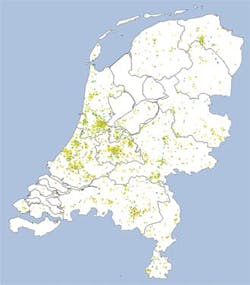ENVIRONMENTAL MONITORING/SPECTROSCOPY: Crowd-sourced measurements offer a unique view of pollution's effects
WILLEM HOVING
Industrialization has provided mankind with many benefits, and at least a few detriments—one of which is air pollution. In fact, air pollution is the reason why, on the basis of sunlight hours, Hong Kong ranks as one of the darkest capitals in the world.
This fact has many implications for life on Earth, and measuring concentrations of pollutants is helpful for addressing areas of need. But determining pollution levels requires measuring aerosols in the air—a task that has traditionally required expensive equipment. That requirement seems about to change, however, thanks to a group of partners in The Netherlands.
Researchers at the University of Leiden, NOVA (Dutch Research School for Astronomy), SRON (Netherlands Institute for Space Research), RIVM (National Institute for Public Health and the Environment), and KNMI (Royal Netherlands Meteorological Institute)—in association with spectroscopy specialist Avantes—are involved in a unique crowd-sourcing experiment that is also a citizen-science project. Winning the Dutch Academy Year Prize in 2012 enabled the partners to develop iSpex, a system that enables any iPhone owner to actively monitor aerosol levels in the air.
Factors in global warming
Two factors are considered the major contributors to the rise in temperature of the Earth's atmosphere—that is, global warming. The first, greenhouse gas emissions, result from the ever-increasing rate of fossil fuel use over the past 200 years. Greenhouse gases, which absorb and emit radiation within the thermal infrared range, remain in the atmosphere for decades or even centuries.
On the other hand are aerosols—that is, suspensions of fine particles (e.g., a dust cloud) or liquid droplets (mist) in gases such as air—which remain for shorter periods of time, typically a few hours but as long as a month. Although a few aerosols can promote global warming, most can be useful in cooling the planet by preventing the sun's rays from reaching the Earth. In general, though, aerosols are not well understood. How aerosols form and what their exact influence is on global warming are some of the many questions yet unanswered that iSpex seeks to help answer.
The idea for iSpex was conceived by Dr. Frans Snik of the Leiden Observatory at the University of Leiden, who inspired and led the interdisciplinary development team—which involved astronomers, space researchers, climate and air pollution specialists, and many students. The name iSpex comes from SPEX (Spectropolarimeter for Planetary EXploration), which is currently being developed for accurate global observations of aerosol properties from orbit around Earth and other planets. The iSpex is used only on this planet, though.
Goals: Awareness and measurement
The founders of the project wanted to create public awareness of aerosols, and decided that the best way to achieve this goal was to involve members of the community. Because 61 percent of Dutch cellphone users are in the possession of a pocket-size computer known as a smartphone, this seemed the logical platform to leverage. Processing power is readily available and the integrated camera can detect light, and a GPS, compass, inclinometer, and Internet connection are inherent. The only thing missing was a means for translating this data into measurement information.
The iSpex does just that. It consists of an app and a small piece of hardware that clips onto a smartphone (see Fig. 1). The hardware combines an optical spectrometer and a polarimeter. It does not measure aerosols directly, but instead measures the spectrum and the polarization of the sky. Sunlight is almost completely unpolarized; that is, it has no preferred direction. Sunlight takes direction only when it hits an aerosol or molecule. The degree of polarization is determined by the size of the particle and its chemical composition. Only by measuring both the spectrum and the polarization under different angles can the composition of the aerosols be determined.
The designers chose the iPhone as the platform because of its ubiquity, and because the camera lens is in the same position on iPhone 4, 4S, and 5 models. This made the design of the device easier and less expensive than it would have been if they had tried to accommodate multiple smartphones.
The first version of the hardware, designed by the project team, was 4 in. in length. In a thorough redesign of iSpex, spectroscopy expert Avantes was asked to contribute its knowledge of optical measurements using CCDs and its expertise with low-cost optical components. A lens was added to reduce size, and a custom baffle structure was created to minimize stray light. The final design enables iSpex to simultaneously generate two measurements, each featuring its own sensitivity and resolution.
In working on the production, the team needed to overcome a number of difficulties. Besides the realization of tools for plastic injection molding of the housing, some clever approaches were needed to handle the tiny pieces of optical plastic foil that are stacked to enable polarization. The orientation of these foil bits is critical for operation, but because there is no visible reference to indicate which side of the foil is "up," and because the foil is subject to static electricity, mayhem ensued when the pieces were cut from large sheets of foil. This problem was solved by perforating stacks of sheets using a production process called kiss cutting, which kept the tiny bits of foil together. In addition, the optical slit had to be able to manage various intensities of light that users in different parts of the country might encounter; that problem was solved by dividing the slit into two regions with different sizes. To speed and coordinate production, partner Bright LED Solutions (Veldhoven, The Netherlands) paid several visits to the production factory in Asia.
Once the device design was completed, the only thing missing was money to enable manufacture of 10,000 pieces. The critical funding, $128,000 (€100,000), was realized through the Academic Year Prize 2012, which the project won in October 2012.
Out in the world
The first 1,000 devices were available one week before Dr. Snik introduced iSpex in a keynote presentation at the Photonics Brokerage Event 2013 (April 24-25, Veldhoven, The Netherlands). In the following weeks, the units were promoted and distributed by a number of organizations: The Lung Foundation Netherlands, KIJK magazine, compressed natural gas supplier CNGnet, and fiber-optic spectroscopy company Avantes. Individuals could order iSpex devices for $3.35 (€2.50) each, including shipping.
After 10,000 add-ons were manufactured and distributed, the partners had only to wait for was a day with clear, sunny skies throughout The Netherlands—an area of 41,543 km2 or 16,039 sq. mi. July 8, 2013, turned out to be the day; the iSpex team organized two major measurement sessions: 8-10 am and 4-6 pm. On that day, nearly 6,000 measurements were made all over the country (see Fig. 2).
When a citizen scientist connects the device to his or her smartphone and initiates a measurement, the installed app uses the phone's integrated GPS to determine the location. The app also instructs the user how to perform the measurement.
Then, once the readings are taken, the phone determines whether the data was gathered correctly, and then sends valid measurement data to the iSpex central database. There, the data are combined with readings obtained by professional measurement stations—and afterward, all data are interpreted.
And the answer is...
The primary goal of this experiment is to determine whether sheer numbers of devices can outperform a limited number of high-end scientific systems. Currently, The Netherlands has 19 air-quality measurement stations. Each one is able to achieve highly stable, high-resolution results using a high-performance spectropolarimeter costing approximately €100,000. Meanwhile, an iSpex costs just $8 (€6) to build.
Can a large number of iSpex devices compensate for relatively low-quality measurements? Stay tuned to find out: In the coming months, the iSpex data will be analyzed and compared to that collected by high-end scientific equipment on the same day. Another iSpex measurement day is scheduled for September 2013.
Willem Hoving is CTO with Avantes, Apeldoorn, The Netherlands; e-mail: [email protected]; www.avantes.com.


